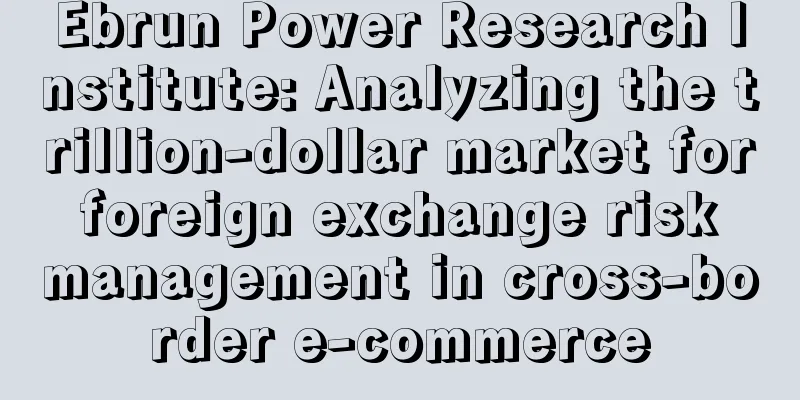Ebrun Power Research Institute: Analyzing the trillion-dollar market for foreign exchange risk management in cross-border e-commerce

|
Cross-border e-commerce is the most dynamic industry and model in current international trade. According to statistics from third-party institutions, in 2017, the scale of China's cross-border e-commerce export transactions reached 6.3 trillion yuan, accounting for 41.1% of the total export of goods trade. The expansion of cross-border payment scale and the instability of the international financial environment continue to amplify the impact of foreign exchange risks. It is estimated that in 2020, the scale of funds affected by foreign exchange risks in China's cross-border e-commerce exports will be close to 800 billion yuan, which is expected to give birth to a new blue ocean of cross-border financial services. Yibang Power Research Institute will use the cross-border financial service platform Haiyunhui as an example to analyze the foreign exchange risk management market in detail. 1 FIRST Cross-border e-commerce has three types of tiered financial needs Compared with domestic online payments, cross-border e-commerce payments and overseas collections have the characteristics of long cycles, long processes, high risks, and stronger financial attributes. With the increase in sales scale and financial management sophistication of cross-border e-commerce companies, there will be three stages of demand for cross-border finance: 1 Basic needs: cross-border payments and overseas collections Cross-border payment and overseas collection are the most basic needs of cross-border e-commerce companies. Fund security, collection time, service fee rate, and supported currencies are the four considerations for companies to choose service providers. Cross-border payment and collection are mainly carried out through four types of service institutions: the first type is third-party payment institutions with cross-border payment licenses, of which there are 30 in China; the second type is foreign payment institutions such as PayPal, Payoneer, and Worldfirst; the third type is foreign banks; and the fourth type is platforms represented by Amazon Global Collection. At present, cross-border payment and overseas collection services are already very mature, with service fees generally below 1%, and competition is becoming saturated.
Figure 1 Expected cross-border e-commerce export transaction scale from 2018 to 2020 Data source: iiMedia Research Table 1 List of third-party institutions in my country with cross-border payment licenses issued by the State Administration of Foreign Exchange
2 Security needs: foreign exchange risk management As long as the business activities of enterprises are settled in foreign currency and there is a time interval, foreign exchange risk will arise. In 2018, the scale of cross-border e-commerce export transactions is expected to reach 7.2 trillion yuan. Calculated at an 8% exchange rate fluctuation, the scale of funds affected by foreign exchange fluctuations is 583 billion yuan. Especially in the past two years, countries along the "Belt and Road" have become the most important incremental market for cross-border e-commerce, but the exchange rate fluctuations of emerging market countries are more obvious, which makes enterprises face greater exchange rate risks. Exchange rate risk management has become an urgent need for enterprises, but only a few service providers have entered this field. Figure 2 Expected impact of foreign exchange risk on cross-border e-commerce payment collection Data source: Calculated by Ebrun Power Research Institute 3 Value-added demand: overseas asset management and other derivative areas According to the financial reports of some cross-border e-commerce companies listed on the New Third Board and follow-up reports on cross-border e-commerce companies, it can be found that there are already companies in China with cross-border retail export scale exceeding 10 billion, and a number of companies with sales exceeding 1 billion.Figure 3: Revenue scale of Global Easy Shopping’s parent company Cross-border E-Commerce Data source: Corporate financial reports Figure 4 Anker Innovations revenue scale Data source: Corporate financial reports As the scale of cross-border e-commerce transactions expands, on the one hand, enterprises choose not to settle foreign exchange for exports and keep funds overseas, generating short-term derivative financial service needs with high liquidity; on the other hand, such as the period from cross-border B2B exports from receipt to settlement of foreign exchange, cross-border B2C accumulates a certain amount of funds and settles foreign exchange uniformly, or listed companies balance financial statements, which will form a certain amount of short-term funds. This part of funds cannot generate value-added and is also subject to exchange rate risks, forming a demand for short-term capital value-added management. At present, the cost of overseas financial institutions absorbing funds from cross-border e-commerce companies is about 6% annualized. Cross-border e-commerce companies generally retain short-term funds for two months. Based on this calculation, short-term value-added management can bring 1% value-added to cross-border e-commerce export companies. Figure 5 Expected scale of short-term asset management income of cross-border e-commerce companies Data source: Calculated by Ebrun Power Research Institute 2 SECOND Foreign exchange risk has become a challenge that cannot be ignored Compared with the service fee rate of less than 1% for cross-border payment and overseas collection, and the 1% income of short-term asset management, exchange rate fluctuations can significantly affect the profit margin of cross-border e-commerce companies. Under the combined effect of internal and external factors affecting cross-border e-commerce exchange rate risks, the pain points of foreign exchange risks of cross-border e-commerce companies have begun to emerge. 1 Cross-border e-commerce timeliness generates foreign exchange risks The timeliness of each stage of the transaction process of cross-border e-commerce is an important factor affecting foreign exchange risk. Taking cross-border B2C payment as an example, from the user placing an order to the merchant settling the payment to the domestic account, there are four stages : the first is the logistics time from the user placing an order, the merchant shipping to the user receiving the goods, which takes 3 to 15 days depending on the country and logistics method; the second is the time for the user to confirm receipt of the product after receiving it, which varies depending on the user's operating habits. The platform automatically confirms receipt of the goods usually takes 5-7 days; the third is the merchant initiating a withdrawal, and the platform transfers the payment to the corresponding collection account. The period from the foreign buyer confirming receipt to the transfer of the payment to the corresponding collection account varies from platform to platform, generally 7-14 days; the fourth is the merchant transfers the payment from the overseas account to the domestic account through the payment service provider and completes the settlement. There are certain differences in the timeliness of different platforms. For example, AliExpress is affected by all four stages of timeliness, while Amazon and eBay do not require buyers to confirm receipt, so they are not affected by the first and second stages of timeliness. 2 Falling profit margins amplify the impact of exchange rate risk my country is a manufacturing powerhouse, and processing trade is one of the mainstays of China's export industry. However, affected by external factors such as the international economic downturn, the rise of trade protectionism, and internal factors such as supply-side reform and rising labor costs, the profit margin of the labor- and resource-intensive processing trade industry has continued to decline, only 2.1%-3.9%. Similarly, factors such as rising costs on the upstream supply side and slowing global market demand have also affected general trade exports and cross-border e-commerce B2B exports, and the profit margins of many companies are usually less than 5%. The profit margin level of cross-border e-commerce retail exports is generally not low, but in a fully competitive market, gross profit margins are constantly declining. At the same time, due to the surge in domestic e-commerce traffic costs, a large number of brands have begun to target foreign markets, and industry profits have been diluted. At present, more than 30% of my country's cross-border e-commerce retail export companies have a profit margin of less than 10%, and more than 40% of companies have a profit margin between 11% and 25%.
Figure 6 Profit margins of various export modes in my country Against the backdrop of declining profit margins, foreign exchange risks are particularly evident. For export companies with a gross profit margin of about 30%, a 10% exchange rate fluctuation could evaporate 40% of their gross profit; and for cross-border e-commerce B2B companies with a gross profit margin generally below 10%, even a 1% appreciation of the RMB would result in a risk of losses. 3 The instability of the international market environment directly affects the exchange rate Policy changes in major trading countries can easily cause sudden fluctuations in exchange rates. In the first half of 2018, affected by a series of political and economic events such as the Trump administration's tax reform bill, the escalation of the Sino-US "trade war", and the Fed's two interest rate hikes, the RMB exchange rate first appreciated and then depreciated, and two-way fluctuations increased. It took only 100 days for the exchange rate to rise from 6.25 to 6.94, and the depreciation rate reached 11%, which exceeded the normal profit margin of general enterprises . The Belt and Road Initiative has become a new market for cross-border e-commerce, which is more vulnerable to exchange rate fluctuations. Since the Russian cross-border e-commerce market dividend exploded in 2013, Brazil, Central and Eastern Europe, Southeast Asia, the Middle East and even Africa have become hot markets for cross-border e-commerce exports. Among them, Russia and Turkey, two countries with a single market size of over 10 billion, are both hard-hit areas of exchange rate risks. The Turkish lira experienced a collapse in August 2018, with a single-day drop of more than 16%; the Russian ruble suffered two sharp drops in April and August. Figure 7: Exchange rate trend of Turkish lira against RMB from April 2016 to October 2018 4 Cross-border e-commerce SMEs lack the means to avoid exchange rate risks Faced with the ever-expanding demand for foreign exchange risk management, there are few exchange rate risk management products suitable for cross-border e-commerce companies on the market. The foreign exchange risk management services of banks have the characteristics of high thresholds, complex application procedures, numerous documents involved, and long acceptance cycles. The approval results are highly uncertain. In addition, banks mainly provide standardized products to serve financial institutions and large enterprises, which cannot meet the transaction scenarios and fragmented needs of cross-border e-commerce companies. Figure 8: Size distribution of cross-border e-commerce export sellers Third-party financial service providers mainly focus on spot exchange rate risk management, and reduce exchange losses by providing exchange rate locks. For example, Airlink provides real-time trading foreign exchange products and locks in real-time exchange rates; Lianlian Pay uses the real-time spot exchange purchase price of the Bank of China, and the withdrawal interface locks in real-time exchange rates for 3 minutes. Under this type of service model, users need to judge exchange rate changes by themselves, and without professional knowledge, they cannot reduce exchange costs by judging short-term and medium-term exchange rate fluctuations. 3 THIRD Haiyunhui entered the market with the background of industrial finance Hai Cloud Exchange is a cross-border financial service platform registered in Hong Kong, providing exchange rate management, risk control and foreign exchange trading services to 4,000 suppliers and 30,000 dealers in the industrial chain of a home appliance group. Currently, Hai Cloud Exchange has begun to expand into the cross-border e-commerce field, providing sellers with currency exchange, cross-border payment, foreign exchange risk management, foreign currency wealth management, foreign currency financing and other services. 1 Two models for small and medium-sized enterprises to participate in foreign exchange trading Cross-border e-commerce companies and individual users mainly conduct foreign exchange transactions through banks. Bank real-time foreign exchange transactions are the main trading method for domestic users, but bank spreads are high, which means higher buying prices and lower selling prices. In addition, banks are not open at all times, so trading needs during certain time periods cannot be met. Hai Cloud Exchange mainly provides foreign exchange trading services for small and medium-sized enterprises. In order to meet the different needs of enterprises, Hai Cloud Exchange provides two trading modes. The group purchase model is fast and efficient. Financial products are virtual products, and customers often have the demand of "buy at any time, sell at any time". Hai Cloud Exchange mainly serves four major types of enterprises and groups: cross-border e-commerce enterprises, cross-border investors, outbound tourists and international students. This allows Hai Cloud Exchange to have a large number of customer trading needs, allowing the group purchase model to continue to operate. Customer trading will also bring market information to Hai Cloud Exchange, making it more accurate in grasping the market. While obtaining better buying prices and more customers, it also has the opportunity to provide risk management consulting services to customers, increase user stickiness, and form a circular effect. Figure 10 Haiyunhui foreign exchange trading group purchase model The matching model eliminates the price difference. For foreign exchange transactions that are not immediate, Hai Cloud Exchange also provides a matching model. By gathering transaction needs in the financial market, a platform for free foreign exchange transactions is provided to achieve automatic matching between buyers and sellers. Since no transaction commission is charged, the matching model not only meets the non-instant foreign exchange transaction needs of both parties, but also attracts a large number of potential customers for the group purchase model, expanding the scale of Hai Cloud Exchange's customer trading. 2 Customized transactions to control foreign exchange risks Traditional foreign trade companies and cross-border e-commerce export companies need to frequently purchase and settle foreign exchange in US dollars due to their large import and export businesses. Some companies use retained US dollar income for external payments, which naturally hedges foreign exchange risks. However, affected by factors such as intensified competition in import and export business, tight cash flow, and declining profits, such companies are in urgent need of innovative exchange rate management products that can not only settle foreign exchange in a timely manner for capital turnover, but also reduce foreign exchange risks and avoid losses. At present, banks provide most of the foreign exchange risk control products. However, the transaction business of traditional banks is profit-centered, providing customers with completely standardized products, and basically not adjusting according to the actual needs of customers. In contrast, Hai Cloud Exchange provides customized foreign exchange risk management services for different business models, transaction scales, and foreign exchange risk types. First, identify and measure the foreign exchange risks of enterprises and determine their maximum loss tolerance; then establish a corresponding risk management system, determine the capital risk control objectives, and clarify the transaction operation mode; conduct trend analysis and transaction sensitivity analysis based on the current situation of the financial market during the service cycle, and formulate a reasonable hedging strategy; finally, inquire with the counterparty to complete the transaction, and monitor the transaction market value risk at any time. Take the customized solution provided by Hai Cloud Exchange for a Thai home appliance manufacturer as an example: Company C introduced large-scale production lines from Europe due to business expansion, and the company has a large demand for purchasing euros every year. Since 2015, the company's procurement costs have been greatly affected by the large fluctuations in the euro against the US dollar. At the beginning of 2016, Company C believed that the EURUSD spot would rebound from the bottom in the next six months and begin to appreciate slightly, but due to the impact of the Fed's interest rate hike expectations, the euro would be difficult to rise sharply, and it is more likely to fluctuate between 1.05-1.15. The company needs to pay several due payments in euros in the first half of 2016. At the beginning of 2016, the EURUSD spot exchange rate was 1.09. The company predicted that the EURUSD spot exchange rate would fluctuate between 1.05-1.15 in the first half of 2016, hoping to lock in some costs below 1.05. Haiyunhui customized a EURUSD spot target double-knock buy forward plan for it. The spot exchange rate at that time was 1.09. The product has a term of one year, monthly pricing, and monthly delivery. If the EURUSD spot rate is higher than 1.04 on the pricing day, the customer buys 10 million euros at 1.04 and accumulates profit points (price on the pricing day - execution price 1.04). If the EURUSD spot rate is lower than 1.04 on the pricing day, the customer buys 20 million euros at 1.04 and does not accumulate profit points. If the accumulated profit points exceed 2,000 points on any pricing day, or the EURUSD spot exchange rate is higher than or equal to 1.15, the product will end early. The advantage of this structure is that it allows the company to buy euros at a price 530 points lower than the 6-month forward exchange rate (1.093) at that time. The risk is that if the product ends early, the customer will have to re-lock the risk; in addition, if the euro depreciates significantly, the company will suffer losses in this transaction. However, the company still bought the euro at an expected price, and from the perspective of the company's overall economic effect, there is actually no economic loss. In fact, the client reached a deal at the end of February 2016. As the company expected, the euro appreciated slightly against the US dollar from February to May 2016, and the transaction soon became profitable. During this period, the company bought 10 million euros at an execution price of 1.04 per month, and finally the cumulative profit points reached 2,000 points at the end of May. The transaction was terminated early, with a cumulative profit of 2 million US dollars. The transaction enabled the company to significantly reduce its own financial costs. 3 Full-scenario embedding reduces the threshold for cross-border financing Cross-border e-commerce transaction cycles are long, and sellers on the platform often have the need to quickly recover funds. Hai Cloud Exchange meets customers' needs for cross-border financing and capital risk management under the condition that foreign exchange risks are controllable and capital costs are reasonable. At present, Hai Cloud Exchange has cooperated with Camel Financial Services Group to fully automate the needs of small and medium-sized merchants on cross-border e-commerce platforms to quickly recover payment for goods through system docking and data sharing in cross-border factoring business. After the goods released by cross-border export enterprises or sellers are shipped after the transaction order is generated on the e-commerce platform, the seller can apply for financing. From the merchant initiating the loan application to the disbursement of the financing funds, it can be completed within 30 seconds, and the foreign exchange risk caused by the long transaction cycle can be effectively avoided. Figure 11 Hai Cloud Exchange cross-border financing product business process In the future, by providing foreign exchange risk management services to cross-border e-commerce platforms and enterprises, Hai Cloud Exchange will gradually launch low-threshold, customized foreign exchange risk management services, try to develop liquidity management products, and create a one-stop cross-border financial service platform. Dong Zheng, Partner of Xiangyu Capital: China has always been a major trading country, and foreign trade-related enterprises have suffered large-scale losses due to exchange rate changes . For large and medium-sized enterprises, they generally hedge potential risks through the management of professional institutions, but most small and micro enterprises have basically no awareness and ability of foreign exchange management and are in a state of resignation. Foreign exchange management requires very professional capabilities, a very deep understanding of the international capital markets and currency markets, and very skilled mastery and application of various financial instruments. The market is in urgent need of institutions that can provide such professional services to a large number of small and micro enterprises. |
Recommend
What is Shenzhen Weiman Cloud Computing Co., Ltd.? Shenzhen Weiman Cloud Computing Co., Ltd. Review
Shenzhen Weiman Cloud Computing Co., Ltd. was esta...
What did I go through when I switched from psychological counseling to Amazon?
Preface of the Little Clone: This week’s Seller S...
New trend! The newest and most popular free off-site traffic diversion tool in 2020!
In 2019, TikTok became popular all over the world ...
What is Seafolly? Seafolly Review
SEAFOLLY is an Australian swimwear brand founded b...
What is Adjust? Adjust Review
Adjust is a data analysis platform that provides a...
How do Amazon sellers prepare for the peak season during the pandemic?
2020 was a difficult year for cross-border sellers...
Before Amazon’s peak season, sellers’ nightmare comes again!
The 618 shopping festival in China has already kic...
The United States is brewing a new e-commerce anti-counterfeiting bill, requiring platforms to strengthen counterfeit supervision
It is learned that after the Consumer Notification...
Amazon's new logistics regulations take effect today! The burden of timeliness is placed on sellers?
As of 2023, cross-border logistics issues remain t...
Big tariff news! The United States announced a new list of
In July, there were reports in the seller circle ...
What is Onion Global? Onion Global Review
Onion Global was founded in 2015 and is a subsidia...
New trend of live shopping: 61% of American consumers actively participate in live shopping
Recently, VTEX released a new study on live shoppi...
What is Global Easy Shopping? Global Easy Shopping Review
Global E-Commerce was founded in 2007, focusing on...
B2B e-commerce share increased to 9%! US manufacturing industry aims at B2B business expansion!
<span data-shimo-docs="[[20,"获悉,根据digital ...
Riding the wave! This big seller's revenue in 2020 increased by 97.96% year-on-year!
The COVID-19 pandemic is still spreading, especia...









